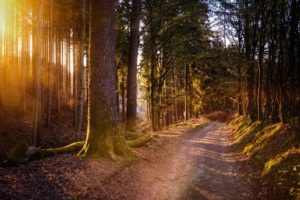Being outside and immersed in nature is healing, and having spent as much time as possible outdoors throughout my life, I know that instinctively. As a practitioner of Chinese medicine, much of my education was based on Taoist teachings that value the benefits of living in harmony with  nature’s cycles. While that may sound a little far out, being in touch with nature can be as simple as eating locally grown foods, listening to the birds in your back yard and noticing the plants sprouting in the garden each spring. When I slow down and pay attention to the changing seasons, I can feel the expansiveness of spring, the bounty of fall’s harvest or the contraction of winter in which the world slows and freezes, and we hunker down like foxes in a burrow.
nature’s cycles. While that may sound a little far out, being in touch with nature can be as simple as eating locally grown foods, listening to the birds in your back yard and noticing the plants sprouting in the garden each spring. When I slow down and pay attention to the changing seasons, I can feel the expansiveness of spring, the bounty of fall’s harvest or the contraction of winter in which the world slows and freezes, and we hunker down like foxes in a burrow.
As an herbalist, I also know that nature can be healing or toxic, especially when it comes to plants. And sometimes it can be both. Modern medicine has amplified both sides of this equation by extracting only what it sees as the single active ingredient from a plant to produce a new drug. This results in powerful medications with equally powerful and sometimes damaging side effects. However, I have seen time and again that by using the whole plant as an herbal treatment, it has the ability to heal more gently than drugs and without the side effects.
Interestingly, in the plant world, a toxin and its cure are often found growing side by side, a phenomenon called companion plants. Where I grew up in New England, the landscape is lined with stone walls, some that are hundreds of years old and falling down. Some are found in what seems to be the middle of nowhere, running through woods that haven’t seen an inhabitant for a hundred years. They represent the borders of what were once farmer’s fields that had been cleared and delineated by those chunks of granite. At the base of these stone walls, weeds and wildflowers grow with abandon, but so does poison ivy, an uneventful looking plant until you’ve accidently brushed up against it. Then, over a couple of days like a slow-motion Polaroid, a rash develops showing you exactly where you made contact.
The curious thing is that the antidote to poison ivy is usually growing nearby in the form of the jewelweed plant. It’s been long known by Native Americans and herbalists alike that the leaves and juice of this wildflower can be used as a treatment for poison ivy, poison oak and stinging nettles. Each time I see jewelweed growing next to poison ivy—toxin and antidote side by side—I’m reminded of the incredible healing wisdom of  nature.
nature.
On a broader scale, there’s a great body of research, initiated by the Japanese, finding that spending time in nature is measurably good for your health. Getting outdoors and experiencing nature is called Shinrin-Yoku by the Japanese, which translates into forest bathing. The benefits of immersing yourself I the woods are quantifiable. Researchers have actually found that taking a walk in green space or a wooded landscape can lower blood pressure, reduce stress, diminish depression and ramp up your body’s immune system. It’s believed that chemicals emitted by the trees are responsible for this effect, but I believe that it’s also because being in nature straight up heals your heart.
Excerpted from Love Pain: Stories of Loss and Survival



